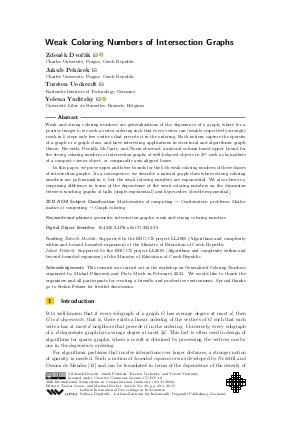@InProceedings{dvorak_et_al:LIPIcs.SoCG.2022.39,
author = {Dvo\v{r}\'{a}k, Zden\v{e}k and Pek\'{a}rek, Jakub and Ueckerdt, Torsten and Yuditsky, Yelena},
title = {{Weak Coloring Numbers of Intersection Graphs}},
booktitle = {38th International Symposium on Computational Geometry (SoCG 2022)},
pages = {39:1--39:15},
series = {Leibniz International Proceedings in Informatics (LIPIcs)},
ISBN = {978-3-95977-227-3},
ISSN = {1868-8969},
year = {2022},
volume = {224},
editor = {Goaoc, Xavier and Kerber, Michael},
publisher = {Schloss Dagstuhl -- Leibniz-Zentrum f{\"u}r Informatik},
address = {Dagstuhl, Germany},
URL = {https://drops.dagstuhl.de/entities/document/10.4230/LIPIcs.SoCG.2022.39},
URN = {urn:nbn:de:0030-drops-160477},
doi = {10.4230/LIPIcs.SoCG.2022.39},
annote = {Keywords: geometric intersection graphs, weak and strong coloring numbers}
}

 Creative Commons Attribution 4.0 International license
Creative Commons Attribution 4.0 International license










